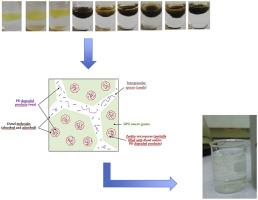Journal of Environmental Management ( IF 8.7 ) Pub Date : 2020-06-28 , DOI: 10.1016/j.jenvman.2020.110939 Samantha Molina Flores 1 , Michel Dumon 2 , Perla Elizondo Martínez 1 , Ma Guadalupe Sánchez Anguiano 1

|
A new adsorbent composite has been developed based on low-density polyethylene and zeolite. This material was used to remove diesel as pollutant in an aqueous system. In the synthesis of the composite and diesel removal were combined these effects: capacity of the zeolite to degrade polyethylene, partial filling of the zeolite with the polyethylene degradation products, favorable thermodynamic interactions between composite-diesel and porosity of the composite (imbibition effect). The term composite is used in the sense that partially degraded-polyethylene oligomers (waxes) are introduced into the zeolite pores in intergranular positions, insuring a good cohesion of waxes and zeolite. The material was synthetized easily by mixing low-density polyethylene and zeolite (1:1) and degraded at 200 °C at three different times: 2, 4 and 6 h. Several techniques as Differential Scanning Calorimeter, Thermogravimetric analysis, Size Exclusion Chromatography and X-Ray Diffraction are combined to study the steps of synthesis and the mechanism of diesel adsorption. The molecular weight obtained at different degradation time varied between 8470 and 99,100, while the molecular weight of the original LDPE was 136,300 g/mol. Diesel removal capacity was determined by TGA through the difference of weight loss at diesel evaporation temperatures (115–275 °C). All the prepared materials presented buoyancy in water and swelling of diesel. Highlighting among them the material prepared at 2 h with a weight loss of 39%, meanwhile the materials prepared for 4 and 6 h presented a weight loss of 29% and 23% respectively, that corresponded to the diesel removed from the water.
中文翻译:

开发了一种新的基于低密度聚乙烯的化合物,该化合物经沸石废物降解后可从水中去除柴油。
基于低密度聚乙烯和沸石的新型吸附剂复合材料已经开发出来。该材料用于去除水性系统中作为污染物的柴油。在合成复合材料和去除柴油中,这些作用结合在一起:沸石降解聚乙烯的能力,用聚乙烯降解产物部分填充沸石,复合柴油之间的有利热力学相互作用以及复合材料的孔隙率(吸水效应)。术语“复合材料”的使用是指将部分降解的聚乙烯低聚物(蜡)以晶间位置引入沸石孔中,以确保蜡和沸石的良好粘结性。通过将低密度聚乙烯和沸石(1:1)混合,可以轻松地合成该材料,并在200°C的三个不同时间(2、4和6 h)降解。结合差示扫描量热仪,热重分析,尺寸排阻色谱和X射线衍射技术,研究了合成步骤和柴油机吸附机理。在不同降解时间获得的分子量在8470和99,100之间变化,而原始LDPE的分子量为136,300 g / mol。TGA通过柴油蒸发温度(115–275°C)下重量损失的差异来确定柴油的去除能力。所有准备好的材料在水中都有浮力,柴油膨胀。其中突出显示了在2 h制备的材料的重量损失为39%,同时在4 h和6 h制备的材料的重量损失分别为29%和23%,相当于从水中去除的柴油。



























 京公网安备 11010802027423号
京公网安备 11010802027423号